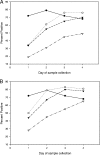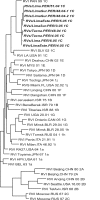Confirmation of rubella within 4 days of rash onset: comparison of rubella virus RNA detection in oral fluid with immunoglobulin M detection in serum or oral fluid
- PMID: 19005151
- PMCID: PMC2620850
- DOI: 10.1128/JCM.01231-08
Confirmation of rubella within 4 days of rash onset: comparison of rubella virus RNA detection in oral fluid with immunoglobulin M detection in serum or oral fluid
Abstract
Rubella virus infection is typically diagnosed by the identification of rubella virus-specific immunoglobulin M (IgM) antibodies in serum, but approximately 50% of serum samples from rubella cases collected on the day of rash onset are negative for rubella virus-specific IgM. The ability to detect IgM in sera and oral fluids was compared with the ability to detect rubella virus RNA in oral fluids by reverse transcription-PCR (RT-PCR) by using paired samples taken within the first 4 days after rash onset from suspected rubella cases during an outbreak in Perú. Sera were tested for IgM by both indirect and capture enzyme immunoassays (EIAs), and oral fluids were tested for IgM by a capture EIA. Tests for IgM in serum were more sensitive for the confirmation of rubella than the test for IgM in oral fluid during the 4 days after rash onset. RT-PCR confirmed more suspected cases than serum IgM tests on days 1 and 2 after rash onset. The methods confirmed approximately the same number of cases on days 3 and 4 after rash onset. However, a few cases were detected by serum IgM tests but not by RT-PCR even on the day of rash onset. Nine RT-PCR-positive oral fluid specimens were shown to contain rubella virus sequences of genotype 1C. In summary, RT-PCR testing of oral fluid confirmed more rubella cases than IgM testing of either serum or oral fluid samples collected in the first 2 days after rash onset; the maximum number of confirmations of rubella cases was obtained by combining RT-PCR and serology testing.
Figures



Similar articles
-
Epidemiology of rubella infection and genotyping of rubella virus in Cote d'Ivoire, 2012-2016.J Med Virol. 2018 Nov;90(11):1687-1694. doi: 10.1002/jmv.25252. Epub 2018 Jul 25. J Med Virol. 2018. PMID: 29984523 Free PMC article.
-
Assessment of RNA amplification by multiplex RT-PCR and IgM detection by indirect and capture ELISAs for the diagnosis of measles and rubella.APMIS. 2010 Mar;118(3):203-9. doi: 10.1111/j.1600-0463.2009.02581.x. APMIS. 2010. PMID: 20132186
-
Evaluation of a commercial rubella IgM assay for use on oral fluid samples for diagnosis and surveillance of congenital rubella syndrome and postnatal rubella.J Clin Virol. 2006 Dec;37(4):265-8. doi: 10.1016/j.jcv.2006.09.005. Epub 2006 Oct 17. J Clin Virol. 2006. PMID: 17049919
-
Challenges of measles and rubella laboratory diagnostic in the era of elimination.Clin Microbiol Infect. 2017 Aug;23(8):511-515. doi: 10.1016/j.cmi.2017.04.009. Epub 2017 Apr 13. Clin Microbiol Infect. 2017. PMID: 28412379 Review.
-
A Biotechnological Review on Patents Applied to Rubella Diagnosis.Recent Pat Biotechnol. 2023;17(4):332-345. doi: 10.2174/1872208316666220902094706. Recent Pat Biotechnol. 2023. PMID: 36056838 Review.
Cited by
-
Rubella epidemic caused by genotype 1E rubella viruses in Beijing, China, in 2007-2011.Virol J. 2013 Apr 18;10:122. doi: 10.1186/1743-422X-10-122. Virol J. 2013. PMID: 23596982 Free PMC article.
-
Oral fluid testing during 10 years of rubella elimination, England and Wales.Emerg Infect Dis. 2010 Oct;16(10):1532-8. doi: 10.3201/eid1610.100560. Emerg Infect Dis. 2010. PMID: 20875277 Free PMC article.
-
Rubella Surveillance and Diagnostic Testing among a Low-Prevalence Population, New York City, 2012-2013.Clin Vaccine Immunol. 2017 Sep 5;24(9):e00102-17. doi: 10.1128/CVI.00102-17. Print 2017 Sep. Clin Vaccine Immunol. 2017. PMID: 28701468 Free PMC article.
-
Rubella.Lancet. 2015 Jun 6;385(9984):2297-307. doi: 10.1016/S0140-6736(14)60539-0. Epub 2015 Jan 8. Lancet. 2015. PMID: 25576992 Free PMC article. Review.
-
Epidemiology of rubella infection and genotyping of rubella virus in Cote d'Ivoire, 2012-2016.J Med Virol. 2018 Nov;90(11):1687-1694. doi: 10.1002/jmv.25252. Epub 2018 Jul 25. J Med Virol. 2018. PMID: 29984523 Free PMC article.
References
-
- Bellini, W. J., and J. P. Icenogle. 2007. Measles and rubella viruses, p. 1378-1391. In P. R. Murray, E. J. Baron, J. H. Jorgensen, M. L. Landry, and M. A. Pfaller (ed.), Manual of clinical microbiology, 9th ed. ASM Press, Washington, DC.
-
- Best, J. M., and S. O'Shea. 1995. Rubella virus, p. 583-600. In E. H. Lennette, D. A. Lennette, and E. T. Lennette, (ed.) Diagnostic procedures for viral, rickettsial, and chlamydial infections. American Public Health Association, Washington, DC.
-
- Centers for Disease Control and Prevention. 2005. Global measles and rubella laboratory network, January 2004-June 2005. MMWR Morb. Mortal. Wkly. Rep. 541100-1104. - PubMed
Publication types
MeSH terms
Substances
Associated data
- Actions
- Actions
- Actions
- Actions
- Actions
- Actions
- Actions
- Actions
- Actions
LinkOut - more resources
Full Text Sources
Medical

